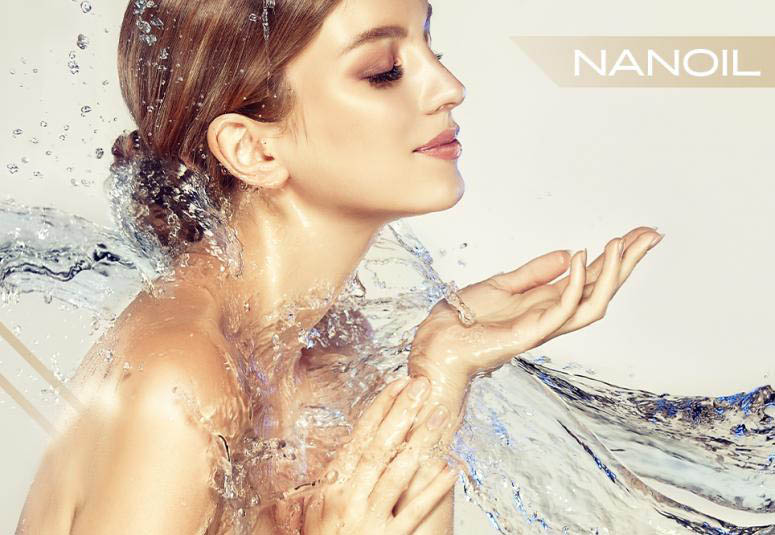- NANOIL Products
- Oils
- Face serums
- Hair masks
- Shampoos
- Hair conditioners
- Hair styling
- Hair Porosity Test
- Blog
- Contact

Hyaluronic acid - another element essential for flawless, young looking skin. A skin care jewel. Sadly, when we grow older, the skin might lose even 50% of the acid. Luckily, we can deliver it with the right products. Learn how hyaluronic acid works, what you can gain and which one is the best.
Hyaluronic acid INCI: hyaluronic acid, sodium hyaluronate
Needle-free botox, no-knife lift, elixir of youth are just three of numerous labels for hyaluronic acid: the most valuable rejuvenating ingredient that has taken over the world of esthetic medicine as well as cosmetic and pharmaceutical industry. It's no wonder because it's like a cooling sip of water on a hot day for the skin. The spring of youth is like a cosmetic superhero: one molecule of hyaluronic acid is able to hold even 4000 times its own weight in water!
Hyaluronic acid is a common chemical compound: it occurs in all living creatures. It's a polysaccharide which makes up the dermis and is stored in the extracellular matrix i.e. two-millimeter layer located right under the epidermis.
Moisturizing power isn't the only thing that hyaluronic acid specializes in. It’s a an extraordinary substance that - together with collagen - keeps skin young and firm. The acid makes the skin soft as marshmallows. Its goal is making skin supple, smooth and youthful. Because it affects the level and condition of collagen in skin, hyaluronic acid is said to be more important than collagen.
When level of hyaluronic acid drops, we automatically look older because aging process is intensified. Between the age of 25 and 50 we lose even 50% of the acid and that's why delivering it from the outside matters so much.

This acid is a main ingredient in moisturizing skin care products: creams, masks, body lotions, all kinds of face toners and hydrosols. It's an essential element of face serums and is often infused into eye creams and antiaging treatments - it must be cross-linked hyaluronic acid because this form doesn't break fast in skin so it has time to fill in wrinkles and enhance the face shape. Once it makes itself comfortable in skin, it acts like a sponge: absorbs and stores water molecules, not letting them escape quickly.
Apart from getting ready products, you can buy pure hyaluronic acid e.g. powder. Still, the form of gel is more popular. The concentration of hyaluronic acid varies (from 1% to 5%). The higher it is, the thicker the product (and slower penetration inside the skin...).
Used solo, hyaluronic acid is likely to evaporate fast taking water molecules away instead of locking them in. That's why mixing it with other ingredients is a better idea - you create a hydrating serum, that is acid solution enriched with other valuable cosmetic substances.
To be able to fulfil its role, hyaluronic acid needs two essential things:
You can make hyaluronic acid work even better. Take a look at the list of ingredients that work wonders when paired with hyaluronic acid:
Hyaluronic acid is an antiaging and anti-wrinkle jewel. Its continuing popularity flows from zero allergic reactions. The biocompatibility of the acid with skin is really high. Hyaluronic acid injections can be done on nearly every area of the body but it's surely done on the face in most cases. The power and density of fillers differ and an esthetician adjusts the procedure to the needs of the skin and your expectations. Hyaluronic acid in wrinkle fillers has a form of clear, elastic gel whereas its molecules are like tissue building blocks.
Hyaluronic procedures aim at reducing wrinkles, enhancing the face features and firming up the skin, and sometimes even making scars less visible. Users usually want this liquid face lift to give a natural effect, correcting the face features and making the skin look younger.
Cross-linked or noncross-linked, high or low molecular weight…? Hyaluronic acid comprises a big family of various molecules which vary in terms of size, effect and benefits for skin. We won't describe them all. Let's concentrate on the two that should be added to the most effective serums and moisturizers:
The effectiveness of hyaluronic acid supplements used to be thrown into doubt but recent tests have shown that this form of HA has benefits for skin too. Sufficient dose of hyaluronic acid is the key thing: around 100 mg per day. Additionally, you should check what your HA is derived from. Ideally, choose natural plant extracted HA. Don't expect instant results, though. You should spot and feel the difference on your skin after three/four months or so. Still, products infused with HA were, are and will be an inseparable element of successful skin care.
Leave your email address and we ll notify you when the product is back in stock.
Comments: #0